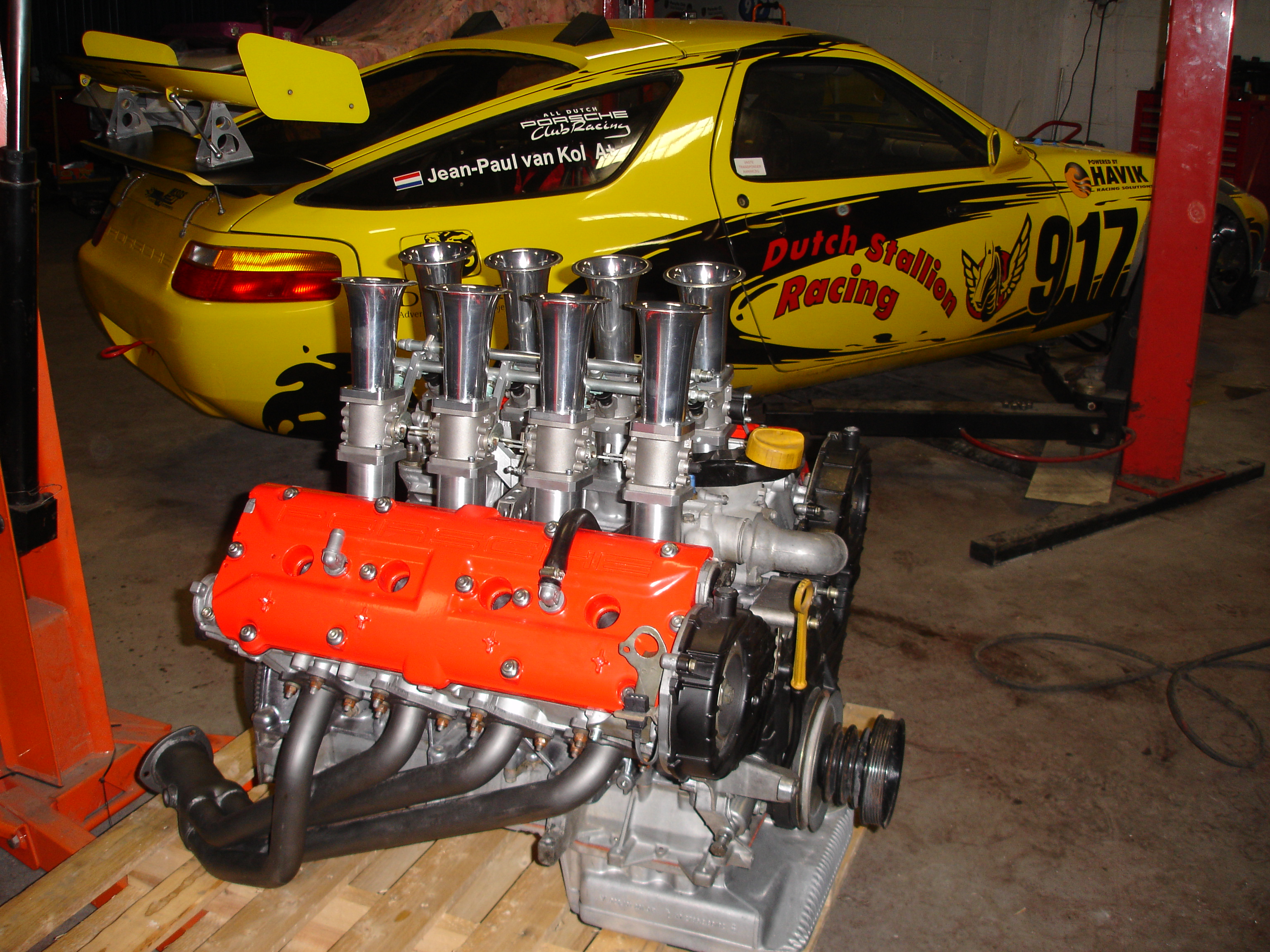|
Update
November 30th, 2011
Hello Kevin,
I need another of your excellent scraper kits (Teflon) for our latest 928 race car which will be fitted with a 5.0 GT motor.
BTW this will be kit number 5 I think and we have not had a single (oil related) failure on any since fitting your scrapers, we also use minimal oil! This is also using the factory breather system without any catch tank and on my own race car max revs is set at 7500 rpm which I use all of!
See http://www.youtube.com/watch?v=WIKOdQkC2_0
Regards,
Paul Anderson
928spares.co.uk
Important, please read!
The stock Porsche 928 V8 wet-sumped engine, both 16V and 32V versions, has two very well known problems at rpms above ~6300 rpm: 1) oil aeration which is definitely fatal to the engine; 2) oil ejection. Many, many attempts have been made by the factory and aftermarket to correct these problems in the 30 plus year history of this engine.
With regards to the fatal problem of oil aeration, the Ishihara-Johnson 928 windage control system allowed the Dutch Stallion team to run their wet-sumped 928 S4 engine at typical rpms of 6800 for the first half of the 43 hour 2006 season (not including practice) and 7200 for the second half with stable oil pressure. This was accompanied by a 10 degree Celsius drop in coolant temperature from the previous years engine which had less power. This years engine is NA and develops 420 rwhp.
To our knowledge safely running this sustained rpm level in the wetsump engine is unprecedented in the history of this engine [click here].
Prior to the installation of the windage control system when they attempted to run their engine at 6800 rpm it failed in two days.
Upon teardown of the engine at the close of the season no discernable damage had occurred in the engine.
 
To be very clear, the windage control system does not and cannot correct the second problem of oil ejection. In some situations it may even make it worse.
Louie Ott, in a Rennlist post suggests:
The oil filler breather I made can be seen on my web site on this page.
http://www.performance928.com/cgi-b...ass_parent=1128
Scroll down to the bottom and there are a couple of pics. I have some basic drawings (no dimensions) which I could email if you want. The inside of the aluminum cap has the threaded part from the old cap. Turn down the outside of the old cap. Turn out inside of the new cap to fit outside of old cap. Epoxy old cap inside the new cap. A hole has to be bored in the old cap to fit over the swivel projection in the center of the new cap. The size of the copper pipe "street L" that goes into the center of the cap is 3/4" and is about the smallest size I'd consider using. If there is a way to use 1" size, use that. It might fit. This was just an experimental thing and it worked out ok. You need to vent a large volume of blowby, but don't want high velocity which would carry oil with it. That's why the largest diameter you can use is best. I don't know what others have made. One key thing is to have the inlet on the underside of the cap project down into the filler so any oil that is on the surface has a hard time turning the corner and going up and out the breather. |
Rob van Kol has used Louie Ott's suggestion and added a baffle trap as well. The oil ejection rate for the Dutch Stallion Team car is now at .25 liters per 50 minutes racing. These suggestions really work.
August 28th, 2006 Rennlist update on the full system in use by Carl Faucett, owner of 928 Motorsports in their supercharged engine:
"We got back late from Blackhawk Farms Raceway last night ...
Blackhawk (for those who do not already know) is a 1.9 mile road course that runs CW with 6 right-handers including a small carosel, and 4 left-handers.
"We ran 3 practice sessions and 4 timed races at 6 to 8 psi of boost with no oiling problems at all. I was/is ecstatic. I kept checking the dipstick and just could not believe it - after every practice session and after every race - my oil level on my stick never moved. I never added oil to it all day.
"Ran out of gas on one event - pitchin' and gulping out of the corners - we put another 10 gallons in the tank and went back out. All toll, I put 15 gallons of gas thru it - but put it back on the trailer at then end of the day with the same amount of oil I came with! Very Happy.
"I took 3rd place in my race group, and 10th overall of a 115 cars that raced. The two cars that beat me were supercharged Mustang Cobras.
"More info for those that want it:
>I was running 15w-40 Rotella motor oil.
>Only 450 miles on this motor, Hour meter says 5 hours - rings are still not quite all the way bedded in.
>The Accusump EPC is set to 40 psi... that means it will not add oil to my oil pan unless my oil pressure drops below 40. Hot motor (190+ deg oil temp) at idle I have 55 psi, more when I rev it (of course)
"Note that:
> I was revving to 6500 RPM, with a peak of 6900 RPM
> we were regularly pulling 1.1 G's in the corners with a peak of 1.2 G's
> we were regularly hitting .7 G's braking
> and .4 G's in acceleration with a peak of .6 G Acceleration"
October 20th, 2006 update:
Carl Fausett reports that after tearing down his supercharged motor this season the bearings look fine. As owners of Porsche 928s know, the 2/6 rod bearings in a wet sump engine are very prone to failure from excessive oil aeration under racing conditions. A 20 degree drop in oil temperature from last season was also noted. Carl finds that the windage system helps with controlling the oil vapor that is typically expressed from the 928 engine under high rpm or boost conditions. Carl runs his motor with 14 pounds of boost and it develops 480 hp.
Carl reinstalled the system and subsequently placed third in the 2007 Pikes Peak Hill Climb Open Class. Congratulations, Carl!
Quotes from users:
~~~~~~~~~~~~~~~~~
Glen Larson, July 8th, 2007:
Kevin,
Wanted to let you know that the first test of the scraper system was very successful. I was concerned that _too little_ oil was coming out of the catch can!
Had about an hour of hard running on the engine. That sort of driving at the track (BIR) had previously produced 1/2 to 1 quart per half hour. After an hour it looked like less than 1/4 quart and there was an oil leak somewhere as well. ...
~~~~~~~~~~~~~~~~~
Greg Gray, March 29th, 2007:
|
Guys and girls I thought that I would mention that I fitted Kevin Johnson's fullcrank scraper/windage setup and have driven around 3500 kms or a bit over 2000 miles. The engine is a new one, by that I mean it has a new bore, very tight clearance, at the bottom end of tolerance, the mileage is basically country or highway miles with the revs about 2500 for most of it but plenty of hard short bursts to the redline, they were certainly not all babied miles that is for sure.
The oil consumption is a tenth of a litre, that is just below the top mark, I'm running a 15w40 diesel oil which is a mineral oil and this was done for running in purposes. I have to say as I built the engine, Kevin's workmanship is first class and he obviously has some investment in his machinery as I couldn't have come close to building anything like what he has done for the money, it is outstanding value that for sure.
I hope you can help me Kevin when I build the 6.0 litre sumped stroker, I can't say how pleased I am so far.
Greg
|
Paul, "Swaybar" on the Rennlist, writes:
"I've run my new engine with the crankscraper for over 4 hours now at Road America (..2:37's - 2:39's) and have come in from those sessions with a virtually cool Accusump. I think if anyone builds a 32v wet-sump motor for the track, and does not install an I-J crankscraper system is asking for trouble, to work along with a drilled crank and an Accusump."
And earlier:
"I have the complete I-J crankscraper system in my new wet-liner engine in my GT race car. As a testament on how well it works, after coming in from a 20-minute session at Road America, the Accusump was barely warm, 80-ish degrees on a 65-degree day; we were flabbergasted it was so cool!
"That crankscraper works so well controlling the oil that the Accusump hardly ever cycles which is borne-out by the Accusump's low temperature after a hard session. Before the crankscraper, the Accusump would be 210-degrees after a session."

For superior servicing of your Porsche 928 in Southern California...please be sure to enquire about Greg's excellent transfer pump system as well.
|
